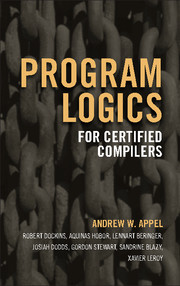Book contents
- Frontmatter
- Dedication
- Contents
- Road map
- Acknowledgments
- 1 Introduction
- I Generic separation logic
- II Higher order separation logic
- III Separation logic for CompCert
- IV Operational semantics of CompCert
- V Higher-order semantic models
- VI Semantic model and soundness of Verifiable C
- VII Applications
- Bibliography
- Index
V - Higher-order semantic models
Published online by Cambridge University Press: 05 August 2014
- Frontmatter
- Dedication
- Contents
- Road map
- Acknowledgments
- 1 Introduction
- I Generic separation logic
- II Higher order separation logic
- III Separation logic for CompCert
- IV Operational semantics of CompCert
- V Higher-order semantic models
- VI Semantic model and soundness of Verifiable C
- VII Applications
- Bibliography
- Index
Summary
Synopsis: Indirection theory gives a clean interface to higher-order step indexing. Many different semantic features of programming languages can be modeled in indirection theory. The models of indirection theory use dependent types to stratify quasirecursive predicates, thus avoiding paradoxes of self-reference. Lambda calculus with mutable references serves as a case study to illustrate the use of indirection theory models.
When defining both Indirection and Separation one must take extra care to ensure that aging commutes over separation. We demonstrate how to build an axiomatic semantics with using higher-order separation logic, for the pointer/continuation language introduced in the case study of Part II.
- Type
- Chapter
- Information
- Program Logics for Certified Compilers , pp. 294Publisher: Cambridge University PressPrint publication year: 2014



